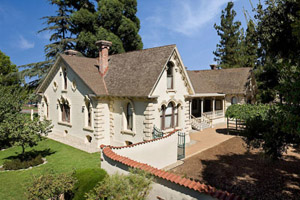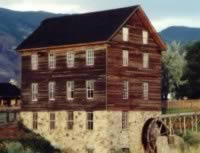I recently read an article in the Tooele Transcript-Bulletin about an historic home located near the Great Salt Lake in Tooele County, Utah. The home was built in the 1850s predominately out of stone and mortar with 18 inch thick walls. The article outlines the historic nature of the home along with some of its locally-known previous owners. This historic home is privately owned and not open to the public. However, the near-by Benson Grist Mill, featuring identical construction and likely built in conjunction with the home, is a Nationally Registered Historic Site.
 This article reminded me of an experience I had with my family about eight years ago. In looking for an activity the family could do together that wouldn’t cost much and could be both fun and educational, I came across a listing for an historical home not too far from where were living at the time. The Workman and Temple Family Homestead Museum is a California Historical Landmark.
This article reminded me of an experience I had with my family about eight years ago. In looking for an activity the family could do together that wouldn’t cost much and could be both fun and educational, I came across a listing for an historical home not too far from where were living at the time. The Workman and Temple Family Homestead Museum is a California Historical Landmark.
Our visit to the home and museum gave the entire family a wonderful insight to life in Southern California as lived between the 1840s and 1930s. We were even surprised to learn that the grounds hosted one of the oldest private cemeteries in the Greater Los Angeles region, and is the burial spot of Pío Pico, the last governor of Mexican California.
Over the years, my family has continued to enjoy historical sites and museums, learning not only our local and national history, but also about the way our ancestors lived. I have grown to feel closer to my ancestors and more appreciative of the hardships they faced which have contributed to the life I live today. I believe my children also have a better understanding and appreciation for their predecessors.
Another thought struct me as I reminisced over our trip to the Workman home. I grew up not far from this historic landmark; yet, I had not heard of it until a few days before our visit. Perhaps the sheer volume of landmarks and activities in California make it difficult for any one site to stand out. After all, even the famous California Missions, one of which is only a few miles from the Homestead Museum, have a tough time competing with local beaches, famous entertainment centers, and the “Happiest Place on Earth.” But, then again, perhaps there are more sites of historic interest all around us then we realize. These sites may just waiting for us to find them. The education we could gain, and perhaps share with our children or grandchildren, would be highly rewarding.
The Homestead Museum describes the value of visiting their site in the following way:
“Cracking open a textbook and reading about major political, economic, and societal changes is one way to learn about history, but having the opportunity to see how real people navigated these changes puts a personal twist on the subject matter—and makes it more intriguing.”
So, I wonder, what are we missing that may be all around us. What historical treasure is waiting for you in your own backyard? What day trip can you take to help strengthen your connection with the past? One great thing about the Internet is your are just one Google search away from answering these questions.

When I read the title of this article, I figured it would be addressing things completely unknown to us, as things that have disappeared and we only know what we do from limited written records or archaeology reports. Often times they are simply local things that disappear over time and while it is happening we think nothing of it. I became acutely aware of this when asked to do some preliminary work on creameries in eastern Iowa. I had grown up taking cream to a butter making creamery as a kid, and figured certainly there was plenty of them around. It ended up I went in search of the last operating creamery and found it gutted only two years after it closed its doors forever. Often with the buildings go the records, all destined for the burn barrel. The earlier records of milk production for individual cows and cow herds seems to not exisit, the type of cows and their production the same. I would recommend that if any reader has come across records of any kind of business that no longer exists to see if the local Historical Society would be interested and if not, try the State Historical Society, these kinds of records are extremely important in making accurate discussions of the way things once were and how these business enterprises affected massive change to a locality.